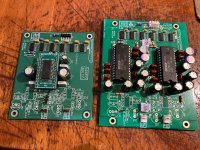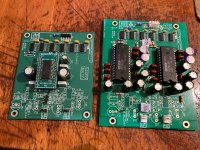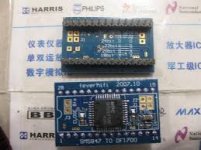Foil capacitors? What foil capacitors?
Wima FKP 2 & 3 are film/foil caps for audio applications among other apps., but through hole part. 63 Vdc - 1,250 Vdc, same size, lead spacing 5mm, for lower values up to 0,047 uF ( bigger size around 15mm lead spacing or there ).
FKP1 & FKP4 are really big, film/foil pusle capacitors, high voltage types. From 1n to 1uf / 400-630Vdc or more to 1,250 Vdc. BIG.
@miro1360 @Brijac : I am fine with everything you said - the only thing that annoys me is connecting 3 times the same ground to the tpa6120 (IR gnd, IL gnd, and PSU gnd) since I am using the same -12v/gnd/+12v PSU for the DAC and the tpa6120. So in my case, can I disconnect IR gnd and IL gnd ? Many thanks
Yes, I know, but wasn't Miro talking about some special caps?Wima FKP 2 & 3 are film/foil caps for audio applications among other apps., but through hole part. 63 Vdc - 1,250 Vdc, same size, lead spacing 5mm, for lower values up to 0,047 uF ( bigger size around 15mm lead spacing or there ).
FKP1 & FKP4 are really big, film/foil pusle capacitors, high voltage types. From 1n to 1uf / 400-630Vdc or more to 1,250 Vdc. BIG.
Kemet PPS are good for audioWima FKP 2 & 3 are film/foil caps for audio applications among other apps., but through hole part. 63 Vdc - 1,250 Vdc, same size, lead spacing 5mm, for lower values up to 0,047 uF ( bigger size around 15mm lead spacing or there ).
FKP1 & FKP4 are really big, film/foil pusle capacitors, high voltage types. From 1n to 1uf / 400-630Vdc or more to 1,250 Vdc. BIG.
https://www.mouser.co.uk/datasheet/2/447/KEM_F3072_SMR-3317008.pdf
Each analog signal in DACs should have its own GND. That means IR gnd and IR gnd is not the same gnd even if they are connected together in several places. It is important to keep each signal+gnd together 🙂@miro1360 @Brijac : I am fine with everything you said - the only thing that annoys me is connecting 3 times the same ground to the tpa6120 (IR gnd, IL gnd, and PSU gnd) since I am using the same -12v/gnd/+12v PSU for the DAC and the tpa6120. So in my case, can I disconnect IR gnd and IL gnd ? Many thanks
I have found PPS is the dielectric that has the least "sounding signature" perfectly doing is HF decoupling job without coloring; it exists in smd too.
I do prefer acrylic from Cornel Dublier though because I often found it "adds" a little organic/very sligth warm thing... I am biased maybe.
Other than the for factor of the Kemet with 5 mm pitch, for some fast op amp better to use 2.5 mm pitch from the Wima MKT line that goes up to 1 uF : at HF, inductance stays the most important thing (for fast op amps that can easily oscillate for some).
Hi Miro can be forced to classA putting a resitor o jfet to ground as JC do on opa ?I thought about sharing the I/V based on TPA6120 for a longer time and today I decided to do it 😎
TPA6120 internal structure is pure CFA, it provides an ultra low impedance load for the DAC.
The internal concept is similar to the AD844, but not the same and TPA6120 is 20x cheaper
Is it good I/V? Well, TPA6120 is very fast CFA, sound is super natural and it has a lot of power to drive things
Power supply range is from +-5V up to +-15V. It can be powered directly from DAC PSU.
R1 and R2 value determines the output voltage. For a higher output voltage use higher value of this resistor (1k5 == 1.5Vp, 2k7 == 2.7Vp, ...).
Capacitors are polypropylene and a high quality electrolytics (UKW from Nichicon is still available).
There is hole in thermal pad under the IC, where you solder the IC with PCB from the bottom.
IL, IR is current input from DAC.
VL, VR is voltage output.
If you are worried about damage to the chip due to a short circuit of the outputs, or signal reflection, you can mount 22R series resistors directly on the signal cable.
Note, that a small (not harmful) DC offset may be present in the voltage output.
This is redesigned PCB and so far not tested, I hope it does work.
BOM example: https://mouser.com/ProjectManager/ProjectDetail.aspx?AccessID=5ca5f6fb0b
@diyiggy Damn, we are devolving onto a 'which cap is best for audio' conversation. I'm sure if you can hear the difference between MKT and MKP then you have been bitten by a radioactive spider... check your web spinners man 😉
It's fascinating how the dielectric film affects audio performance, difference between tin and aluminium foil? Good point regarding lead spacing by the way.
What you said about the warmth of acrylic had me thinking: the various NOS DAC chips we are playing with all have individual attributes. For me the two ends of the spectrum would be AD1865 vs PCM58, the AD1865 is lean, tight and open sounding, the PCM58 is thick, chunky and VERY full bass, it really has texture.
So I would say acrylic is not best for the PCM58 but better for AD1865, the PCM58 would be good with MKT. And so on, all very subjective of course.
The AD1865 is excellent with the simple tube IV by Grunf and Mike (the Sovtek 6N23P tube makes everything sound good to be fair)
In the pic below the 1865 DAC has FCs and MKT caps, and really sounds great, the PCM63 (my favourite) also has Pana ECQ polyester caps and actually sounds superb. I will try another build with Kemet PHE MKPs (they are in my stash)

The PCM63 has organic polymer caps on digital rails, this was a reflex action as I thought they are best here, I recently read (possibly from you) that this may not be the case, however @zoom777 also uses them here so they can't be that bad! Rubycon ZLH is a good one for this position possibly.
It's fascinating how the dielectric film affects audio performance, difference between tin and aluminium foil? Good point regarding lead spacing by the way.
What you said about the warmth of acrylic had me thinking: the various NOS DAC chips we are playing with all have individual attributes. For me the two ends of the spectrum would be AD1865 vs PCM58, the AD1865 is lean, tight and open sounding, the PCM58 is thick, chunky and VERY full bass, it really has texture.
So I would say acrylic is not best for the PCM58 but better for AD1865, the PCM58 would be good with MKT. And so on, all very subjective of course.
The AD1865 is excellent with the simple tube IV by Grunf and Mike (the Sovtek 6N23P tube makes everything sound good to be fair)
In the pic below the 1865 DAC has FCs and MKT caps, and really sounds great, the PCM63 (my favourite) also has Pana ECQ polyester caps and actually sounds superb. I will try another build with Kemet PHE MKPs (they are in my stash)

The PCM63 has organic polymer caps on digital rails, this was a reflex action as I thought they are best here, I recently read (possibly from you) that this may not be the case, however @zoom777 also uses them here so they can't be that bad! Rubycon ZLH is a good one for this position possibly.
I 100% agree : a cap is chosen within the context of the device and the whole devices after : what you ear is the summ of that and it is a usefull tool than passive parts used to tune the tones, of course not the only one. But it surprises me all the time about it can be heard with good devices.
I want to connect it like this.
I don't need to move registers under I2S RJ/LJ for PCM63, do I? Or do I need to do something else?

I don't need to move registers under I2S RJ/LJ for PCM63, do I? Or do I need to do something else?
This a NOS project...
You just need to connect the I2S lines to eachothers as your shematic not forgeting a gnd line, power, then cross the finger !
You will know the I2S pins in and out of your pcb by reading the manuel of your filter board. Hopping it is just a filter and all is staying I2S.
I think the ad1862 board is ok up to 192 Khe maybe more if the filter you have also upsample.
There is a chance it makes more harm than a progress... due to all the not clean conections and power supplies and added length. But who knows ?! Go figure...
You just need to connect the I2S lines to eachothers as your shematic not forgeting a gnd line, power, then cross the finger !
You will know the I2S pins in and out of your pcb by reading the manuel of your filter board. Hopping it is just a filter and all is staying I2S.
I think the ad1862 board is ok up to 192 Khe maybe more if the filter you have also upsample.
There is a chance it makes more harm than a progress... due to all the not clean conections and power supplies and added length. But who knows ?! Go figure...
@zoom777 might have another one left Bernd, his are best they have the JLsounds USB module on board.
I have one left with the standard I2S input and op-amp output.
Do you have a preference for which USB input module you want to use? (or SPDIF - I2S input ?)
I have one left with the standard I2S input and op-amp output.
Do you have a preference for which USB input module you want to use? (or SPDIF - I2S input ?)
Last edited:
@passive420, the one i sent you is the last of my boards, because i have also sent one free board to US.... 🤣
No worries Tan maybe Bernd will have my last one here. You have been very generous pal 👍
@baggerbole, I have one like this type for you - one on the right, I'll also send you an AD1865 board to play with. I also have a spare XMOS USB module if you need USB input.
What is your music source Bernd?

@baggerbole, I have one like this type for you - one on the right, I'll also send you an AD1865 board to play with. I also have a spare XMOS USB module if you need USB input.
What is your music source Bernd?

- Home
- Source & Line
- Digital Line Level
- DAC AD1862: Almost THT, I2S input, NOS, R-2R



